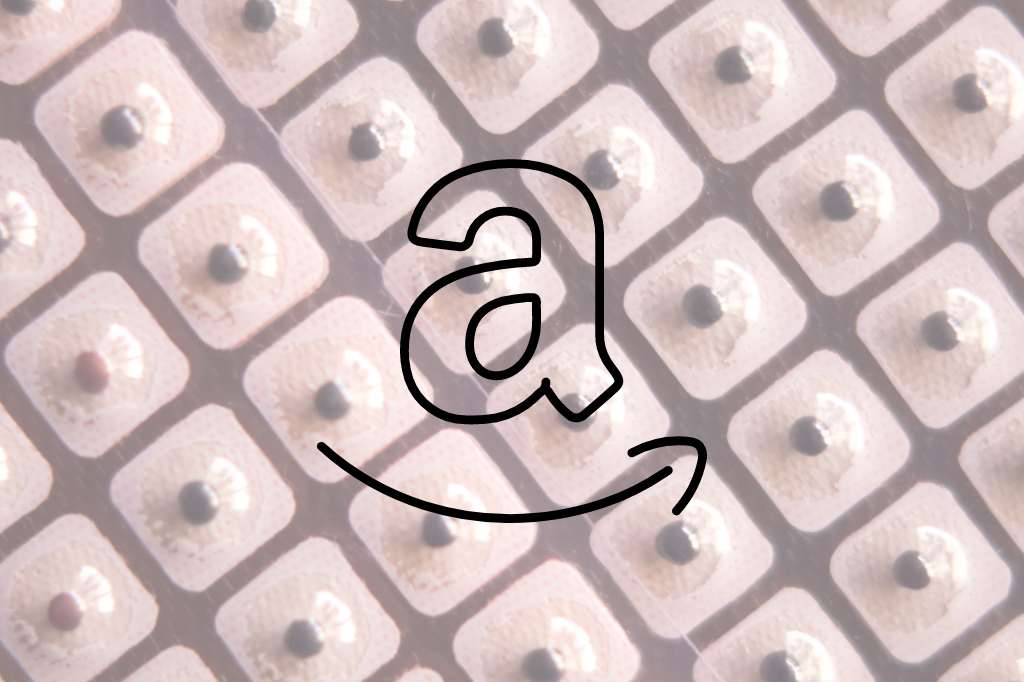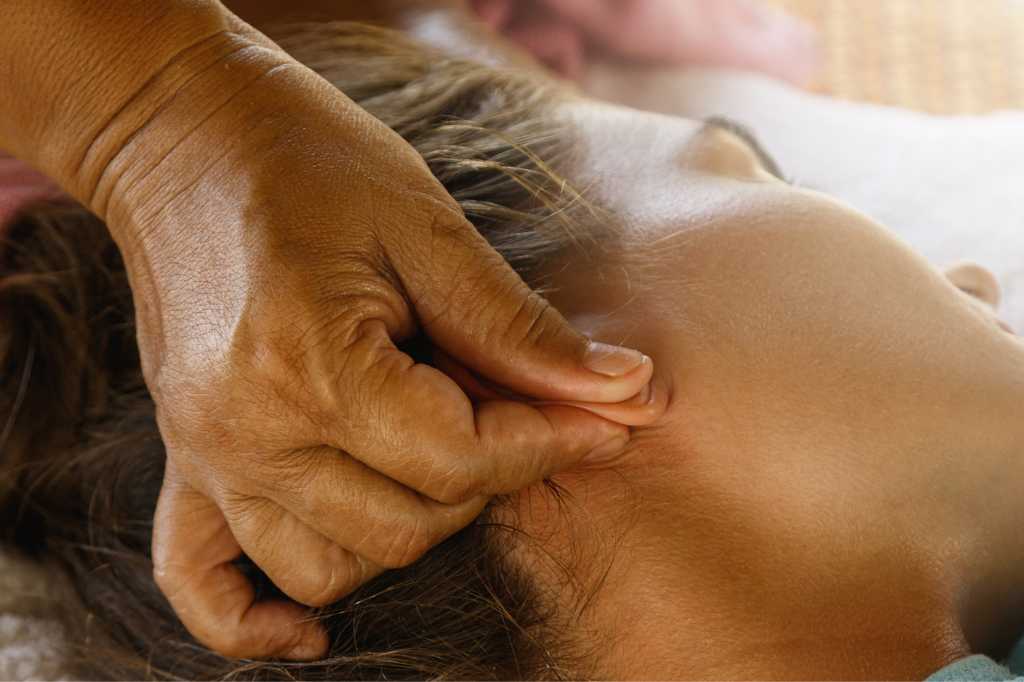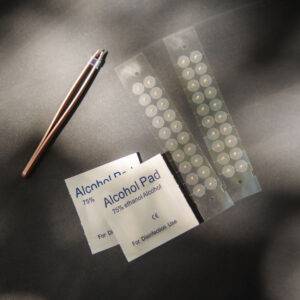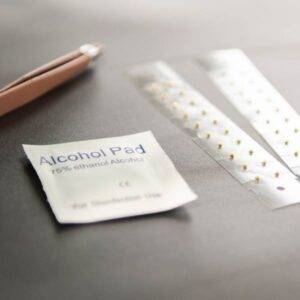Are you one of the 10-25% of adults suffering from tinnitus, or the phantom ringing, whistling, hissing or squealing in one or both ears? Tinnitus is not only frustrating, it can and does cause anxiety and depression, not to mention hearing loss in some people.
According to the National Institute on Deafness and Other Communication Disorders‘ info page, last updated in May 2023, “Currently, there is no cure for tinnitus, but there are ways to reduce symptoms.” Sound therapies, behavioral therapies, and medications are listed by the NIDCD as methods of symptom reduction.
What’s not listed, however, is auriculotherapy, or the modality of tinnitus symptom reduction through ear acupuncture or ear acupressure. Ear seeds for tinnitus could potentially help, and this article explains why.
Disclosure: This article contains affiliate links. When you click an affiliate link and make a purchase, we may earn a commission at no additional cost to you. These commissions help support and maintain our business. Thank you for your support!
But first, what are ear acupressure and ear seeds?
Auriculotherapy has roots in Traditional Chinese Medicine, documented thousands of years back. The theory behind auriculotherapy is that the human ear is a microcosm and microsystem of the body as a whole.
Different places, called points, on the outer ear correspond to different body parts and systems, as studied extensively by both Chinese and European researchers.
By placing needles (in the case of acupuncture) or pressure with ear seeds or some other device (in the case of acupressure) on those acupoints, signals are sent to those specific body parts and/or systems to promote and unlock the body’s own healing mechanisms.
Ear seeds can be a conduit for which this happens. As tiny metal beads that stick to the ears with adhesive tape, they’re a great alternative to acupuncture, the more common form of auriculotherapy, because:
- They can be applied by yourself with some practice and guidance (we recommend and offer virtual ear seeds consultations for additional guided video assistance and peace of mind)
- They are widely accessible
- Ear seeds are inexpensive relative to other types of health and wellness therapies
- They have been used in many research studies and are evidence-based
If you’re new to ear seeds, we suggest the My First Ear Seeds Kit (grab it through the button below), which includes almost everything you need to get started: ear seeds, tweezers, alcohol wipes, and an info card to learn more about your condition and to access an acupressure point chart.
As always, talk to your healthcare provider before starting any new therapies or treatments, and refer to our disclaimer in the footer of our website. We are advocates of informed consent, but also know that ear seeds generally have no or minimal side effects, which you can read about in our article about ear seeds’ side effects here.
Once you have your ear seeds, you can apply them in just a few simple steps, starting with gathering your materials and washing your hands. Next is lifting them off the plastic backing strip with tweezers, sticking them on your targeted ear points, and pressing to “set” them with your fingertips.
What does the research say about auriculotherapy and tinnitus?
Although the research on auriculotherapy and tinnitus is limited with opportunity for more and larger studies, some data exist showing that it may be directionally helpful in reducing tinnitus symptoms.
According to 2014 Tinnitus Guidelines as documented in a 2023 Journal of Audiology & Otology article, acupuncture is not recommended as a treatment. The same article, however, cites a secondary article that says it has potential to be effective at a micro level because everyone is different. In addition, placebo effects may influence positive outcomes.
A 2021 auriculotherapy-tinnitus study concluded that acupuncture on specific ear points including Shen Men, Kidney, and Inner Ear was more effective alongside conventional therapy in reducing tinnitus than conventional therapy alone was.
A 2009 study assessed acupuncture coupled with antioxidants to reduce tinnitus. Tinnitus noise and intensity improved, but results were not significant, so the researchers couldn’t definitively conclude that the treatment did indeed have a clear impact.
In their systematic review and meta-analysis, also published in 2021, Huang and team call for “further rigorous and high-quality studies with larger sample sizes.”
So overall, the research is limited, and we’d like to call on researchers to conduct more studies, especially on ear seeds for tinnitus.
Ear seed placement chart for tinnitus
The Auriculo 360 app shows several different placement points you can try for tinnitus. Start by choosing 3-6 points, seeding the same spots on both ears, and following the 4-3-1 Rule, where you:
- Use ear seeds consistently on the same points for a minimum 4 weeks, changing them out every 3-5 days
- Stimulate your ear seeds for tinnitus 3 times per day by applying gentle to moderate pressure with your fingertips
- Time yourself to ensure you’re stimulating the seeds for 1 minute each time
After at least four weeks (but preferably six), move onto a different set of acupressure points for ringing ears if you’d like.
Primary points for ear seeds for tinnitus are marked by the GREEN dots in the ear below:
- Adrenal Gland.C&E (the C indicates a Chinese Auricular Point, and the E indicates a European Auricular Point)
- Cervical Spine
- Ear (External).C
- Ear (Inner).C
- Kidney.C
- Lesser Occipital Nerve
- Master Sensorial
- Occiput
- Point Zero
- San Jiao
- Shen Men
- Shoulder
The PURPLE points in the ear below reflect group points for ear seeds for tinnitus.
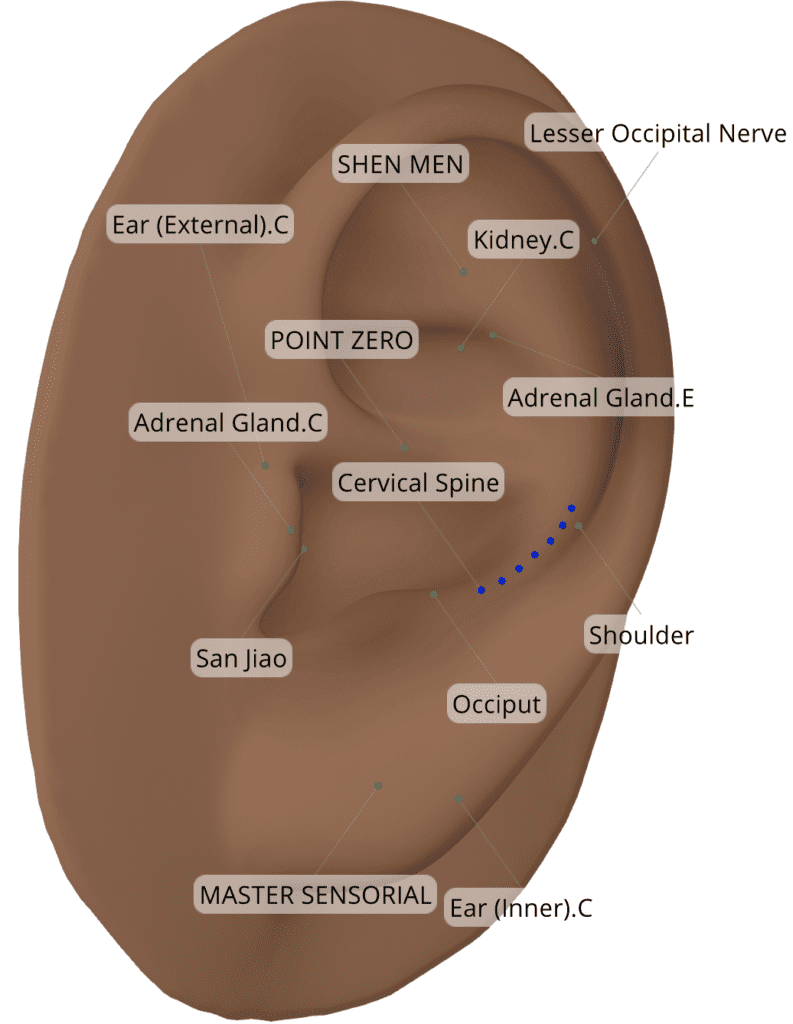
In the book The Ear: Gateway to Balancing the Body, A Modern Guide to Ear Acupuncture, renowned acupuncturist Mario Wexu, D. AC. divides tinnitus into three groups based on Chinese literature:
- Cicada singing
- Big buzzing
- Little buzzing
Wexu provides a list of acupoints for tinnitus, but the protocol is more complex and is best read and interpreted by an actual acupuncturist.
Which leads us to the next section…
Why we recommend the Auriculo 360 app for tinnitus ear seed placement
Auriculo 360, which offers a 30-day trial, is the leading auriculotherapy software for several reasons:
- Draws upon extensive research into 400+ points and protocols from both Chinese and European auriculotherapy frameworks
- Features a 3D ear that you can move, zoom, expand, and rotate to see hidden ear points, such as behind the ear (for some protocols and conditions)
- Is easy for the everyday person, who’s not trained in auriculotherapy, to use
- Allows you to customize ear skin color and device language (up to 5 variations of each)
- Is available across devices, from your smartphone to your computer
Sure, you can grab ear seeds for tinnitus charts almost anywhere on the internet. But because the precise points are so critical in actually helping with tinnitus (or any condition), you can feel confident using Auriculo 360 as your guide for tinnitus ear seed placement.
Try ear seeds for tinnitus — it may work for you
Anyone who doesn’t have tinnitus doesn’t understand the challenges of this condition and the lengths people go to alleviate it.
Transparently, ear seeds may or may not help you with tinnitus — at My Ear Seeds we stay away from healing claims because a) making such claims prohibited, b) acupuncture is not part of the recommended tinnitus therapies according to national guidelines, and c) we understand that everyone is uniquely different and what works for some does not work for all.
With that being said, tinnitus protocols for auriculotherapy do exist. So if you have an interest in trying ear seeds for tinnitus and you’ve discussed this with your healthcare provider, we’d like to be your go-to source for the ear seeds. Try acupressure for ringing ears and see if that brings any relief. Tap the button to shop our Ear Seeds & More store!
Resources:
Huang, K., Liang, S., Chen, L., & Grellet, A. (2021). Acupuncture for tinnitus: a systematic review and meta-analysis of randomized controlled trials. Acupuncture in medicine : journal of the British Medical Acupuncture Society, 39(4), 264–271. https://doi.org/10.1177/0964528420938380
Lee, H. Y., & Jung, D. J. (2023). Recent Updates on Tinnitus Management. Journal of audiology & otology, 27(4), 181–192. https://doi.org/10.7874/jao.2023.00416
Lorente Sánchez, Y., Expósito Pérez, A., & Ferriol Rodríguez, M. (2021). Auriculoterapia como tratamiento coadyuvante en el acúfeno. Revista Cubana de Otorrinolaringología y Cirugía de Cabeza y Cuello, 5(2). Recuperado de https://revotorrino.sld.cu/index.php/otl/article/view/238/396
Shaladi, A. M., Crestani, F., & Saltari, R. (2009). Auricular Acupuncture Plus Antioxidants in the Treatment of Subjective Tinnitus: A Case Series. Medical Acupuncture, 21(2), 131-134. http://doi.org/10.1089/acu.2009.0662

